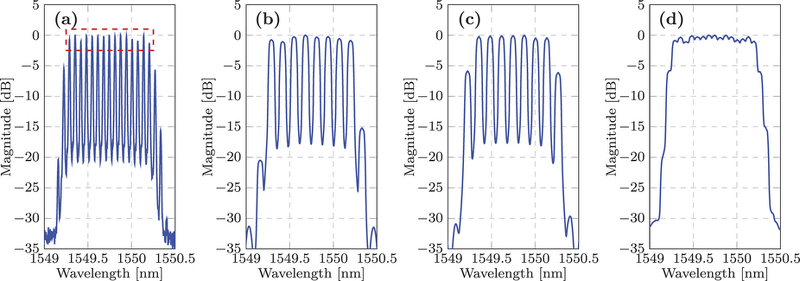Researchers at University College London successfully transferred data over an optical transmission system at a rate of 1.125 Tb/s. That’s over ten times as fast as typical commercial optical systems, and thousands of times faster than the standard broadband connection. The study appeared in Scientific Reports and takes advantage of encoding techniques usually seen in wireless systems.
The prototype system uses fifteen channels on different wavelengths. Each channel used 256QAM encoding (the same as you see on cable modems, among other things). A single receiver recovers all of the channels together. The technology isn’t commercially available yet. It is worth noting that the experiment used a transmitter and receiver very close to each other. Future tests will examine how the system performs when there are hundreds or thousands of feet of optical fiber between them.
We’ve covered information theory earlier this month, and those same principles allow more data to travel on a single fiber. Here we’ve just been using fiber optics for lighting. If you want to understand how fiber optics work (with a cool antifreeze demonstration), you might find the video from [engineerguy] below interesting.
















As long as I can burn through my monthly 4G cap in less than 10 minutes, it’s fast enough.
My thoughts exactly. Why bother with this shit when companies still have data caps? That’s… kinda like advertising how fast you’ll hit the brick wall then have somebody come by to rob you.
You’re not seeing the forest for the trees, you have a cap because “worldwide fiber optic system” is not rated at unlimited bandwidth. Enhancing those links your cap will probably go lower. If everybody in the world would not have any bandwidth cap probably would be like everyone gets 33.6K
As usual the bottle neck will be processing the data from the link fast enough, ie getting one packet off the wire and up the stack before the next one is ready can be a challenge..
Why up the stack if there’s a TDM, MPLS or ethernet switch at end (ie nothing higher than L2 or L2.5)?
How far was the fibre for this test captain? And how quickly can you unspool fibre while you’re driving down the road, for mobility?
+1
This is a clear example of the applications of Multiple Description Coding..
Yeah what’s the point of comparing an optical fabric to 4G?
Take this SR-71 for a ride, now doesn’t your Civic feel slow?
The SR-71 makes EVERYTHING feel slow :)
http://oppositelock.kinja.com/favorite-sr-71-story-1079127041
http://oppositelock.kinja.com/what-was-the-slowest-you-ever-flew-in-the-blackbird-1501361885
^disregard^
http://oppositelock.kinja.com/what-was-the-slowest-you-ever-flew-in-the-blackbird-1501361885
Anything that can reach a stable Earth orbit is quite literally several times faster then the SR-71 can max out :P
But, hows the throughput?
It’s the technology rather than the speed that’s interesting here – back in 2014 BT and Huawei did 3Tbps over a real-world (359km) fibre link using 15x200Gbps 16QAM channels. 256QAM should definitely be able to exceed those rates in future, and this says it’s the “highest throughput (1.125 Tb/s) ever recorded using a single coherent receiver” which I guess means BT used multiple bonded receivers.
Earlier in 2014 BT and Alcatel-Lucent also did 1.4Tbps in another real-world scenario with the same 200Gbps 16QAM channels (only 7 channels)
Links:
BT & Huawei 3Tbps – http://www.btplc.com/news/Articles/ShowArticle.cfm?ArticleID=476A9AC1-58A4-44EE-A067-871356A12950
BT & Alcatel-Lucent 1.4Tbps – https://www.alcatel-lucent.com/press/2014/alcatel-lucent-and-bt-achieve-fastest-real-world-fiber-speeds-14tbs-world-record-spectral
Technically 4G/LTE 4×4 IS slow. Who is going to download 2GB in a day when 2GB costs hundreds of dollars? Websites these days are typically at least 10MB..
Unlimited, non throttled users.
In South Africa, 2GB costs just a few dollars.
The title of this article is misleading. I thought you were going to mention something about 5G. And since I work with both LTE and the-now-early-days-5G, I thought I was going to learn something new.
Putting fiber optics and LTE in the same headline is wrong. Two technologies trying to solve very different things, with very different physical constraints.
Word.
I’ve calculated the maximum theoretical limit of the channel according to Rud’s article http://hackaday.com/2016/02/05/grandmas-phone-dsl-and-the-copper-they-share
using the bandwidth in the 1549ns to 1550.5ns range, and 256 levels. It came out 2.99Tbit/s, so we’re pretty close.
What’s the bandwidth of a van full of backup tapes on an 80 MPH highway?
It goes through the roof but there’s a 28.800.000ms latency
39 millijumbojetsfullofDECtape. Never underestimate that bandwidth.
Now there’s a QKCD worthly competition… a freight train or an A380 full of storage media? (because of the weight constraints in the plane, you’d probably need different media for each)
Ah, the “Bart Simpson Spectral Density Function” – How’s it Hangin’ Dude?
The processing of quam is also why your cable boxes are always on. The exciting part is the one sensor part. In the cable world quad blocks are each spliced together and patched into a single signal. So this could stack like cable.